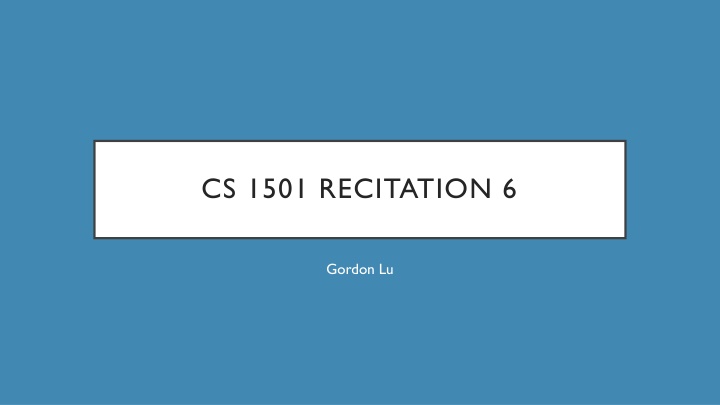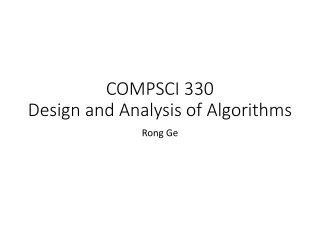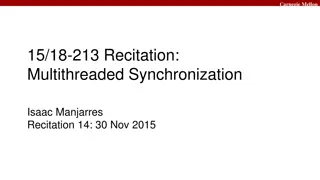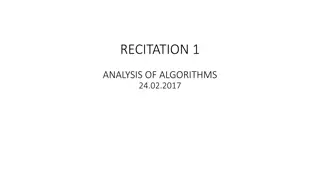CS 1501 RECITATION 6
The Minimum Spanning Tree Problem involves finding the connected subgraph with the smallest weight in a weighted graph, important for real-world applications like network design. Prim's Algorithm is a well-known method for constructing a minimum spanning tree efficiently. This algorithm selects edges of minimum weight to grow the tree until all vertices are connected.
Download Presentation

Please find below an Image/Link to download the presentation.
The content on the website is provided AS IS for your information and personal use only. It may not be sold, licensed, or shared on other websites without obtaining consent from the author.If you encounter any issues during the download, it is possible that the publisher has removed the file from their server.
You are allowed to download the files provided on this website for personal or commercial use, subject to the condition that they are used lawfully. All files are the property of their respective owners.
The content on the website is provided AS IS for your information and personal use only. It may not be sold, licensed, or shared on other websites without obtaining consent from the author.
E N D
Presentation Transcript
CS 1501 RECITATION 6 Gordon Lu
AGENDA FOR TODAY Minimum Spanning Tree Algorithms Prim s Shortest Path Algorithms Dijkstra s Bellman-Ford Questions for Project 3?
THE MINIMUM SPANNING TREE PROBLEM Let G be a connected graph each of whose edges is assigned weights or costs. G is then called an edge-weighted graph. A spanning tree of a graph is a connected subgraph with no cycles including all vertices. The Minimum Spanning Tree Problem: For each spanning tree S of G, define the weight as ? ? = ? ?(?)?(?). Our goal is to find the spanning tree with the smallest weight. Finding such a spanning tree has many real-world applications! Networks
PRIMS ALGORITHM (MATH WAY) A well-known algorithm for finding the MST in a connected weighted graph is Prim s Algorithm. Prim s Algorithm: For a connected weighted graph G of order n, a spanning tree T of G is constructed as follows: For an arbitrary vertex u for G, an edge of minimum weight incident with u is selected as the first edge ?1of T. For subsequent edges ?2, ,?? 1, we select an edge of minimum weight among those edges having exactly one of its vertices incident with an edge already selected.
WHY TREES HAVE N-1 EDGES Theorem: Let G be a graph of order n and size m. If G has no cycles and m = n 1, then G is a tree. Recall that a tree is an acyclic connected graph Recall that a connected graph is a graph that has a u-v path ?,? ?(?) Proof: If G has n-1 edges and no cycles, this implies that there are no isolated vertices, hence deg ?? 1 ? {1, ,?}. Since there are no isolated vertices, and n-1 edges, the longest u-v path must be geodesic in ? 1, hence G must be connected. Since there are no cycles and G is connected, G must then be a tree. If there are > ? 1 edges, there must be a cycle. Why?
PRIMS ALGORITHM (CS WAY) Algorithm: 1) Start with any vertex ? as a single vertex tree 2) Then add V-1 edges to it, always taking the next minimum weight edge that is incident to ? connecting it an unseen vertex ?. There are two approaches: Lazy Prim Eager Prim
IMPLEMENTATION OF PRIMS ALGORITHM: DATA STRUCTURES Before discussing Lazy Prim and Eager Prim, we need to call upon the aid of some old friends: 1) marked[ ]: A vertex-indexed boolean array. marked[v] is true if v is on the MST. 2) edgeTo[ ]: A vertex-indexed array of Edge objects edgeTo[v] is the Edge that connects v to the tree (What vertex I came from to get to v) 3) MinPQ<Edge>: Priority Queue that compares edges by weight.
EAGER PRIM V.S. LAZY PRIM Each time we add an edge to the MST, we also add a vertex. We add all edges from said vertex into the PQ to other vertices not in the MST in order to consider candidate MST edges. We must also consider any edge connecting the vertex just added to a MST vertex that is already on the PQ to be invalid (as it connects two MST vertices) A lazy implementation leaves such edges on the PQ, deferring the eligibility to when they are removed. An eager implementation removes such edges from the PQ right away.
LAZY PRIM CODE Lazy Prim will take ?(? log?) to compute the MST. Let s code it up now!
EAGER PRIM To improve Lazy Prim, we might try to delete ineligible edges from the priority queue, so that the priority queue contains only the crossing edges between tree vertices and non-tree vertices. But we can eliminate even more edges. The key is to note that our only interest is in the minimal edge from each non-tree vertex to a tree vertex. In other words, we maintain on the priority queue just one edge for each non- tree vertex w : the shortest edge that connects it to the tree. Any longer edge connecting w to the tree will become ineligible at some point, so there is no need to keep it on the priority queue.
EAGER PRIM CODE Lazy Prim will take ?(? log?) to compute the MST. Let s code it up now!
A FINAL REMARK 1) Do Prim s and Kruskal s algorithms work for directed graphs? No. That is a much more difficult graph theory problem referred to as the minimum cost arborescence problem. 2) Can you modify Eager Prim so that a d-way heap is used instead? (This is referred to as Johnson s Algorithm.) 3) An MST edge whose deletion from the graph would cause the MST weight to increase is called a critical edge. Show how to find all critical edges in a graph in time proportional to E log E . Hint: Consider degree sequences.
THE SHORTEST PATH PROBLEM Let G be a connected digraph each of whose edges is assigned weights or costs. G is then called an edge-weighted digraph. A directed path in an edge-weighted digraph has an associated path weight, which is the sum of the weights of that path s edges. The Shortest Path Problem: For two vertices u and v in an edge-weighted digraph G, our goal is to find the lowest- weight directed path from u to v. The shortest path from vertex ? to vertex ? in an edge-weighted digraph is a directed path such that no other path has a lower weight.
SHORTEST PATH CONSIDERATIONS Single-source shortest paths: Given an edge-weighted digraph and a source vertex s, support queries of the form Is there a directed path from s to a given target vertex t? If so, find a shortest such path (one whose total weight is minimal). Our SP algorithm will assume that edge weights are positive. The second SP algorithm we consider will resolve this issue.
SHORTEST-PATHS TREE Here, we will focus on the single-source shortest-paths problem, where we are given a source vertex ?. The result of the computation is a shortest-paths tree (SPT), which gives a shortest path from ? to every vertex reachable from ?. A shortest-paths tree for a source vertex ? is a subgraph containing ? and all the vertices reachable from ? that forms a directed tree rooted at ? such that every tree path is a shortest path in the digraph.
DATA STRUCTURES FOR SHORTEST PATHS Before discussing some SP algorithms, we ll need some data structures: 1) edgeTo[ ]: An parent-edge representation in the form of a vertex-indexed array edgeTo[v] is the edge that connects v to its parent in the tree (last edge on a SP from s to v) 2) distTo: A vertex-indexed array such that distTo[v] is the length of the SP from s to v. We use Double.POSITIVE_INFINITY to denotes vertices that are not reachable from the source.
EDGE RELAXATION The SP implementations that we ll be interested are based on a simple operation known as relaxation. Edge relaxation is defined as follows: to relax an edge v w means to test whether the best-known way from s to w is to go from s to v, then take the edge from v to w, and, if so, update our data structures to indicate that to be the case. The best-known distance to w through v is the sum of distTo[v] and e.weight() if that value is not smaller than distTo[w], we say the edge is ineligible, and we ignore it; if it is smaller, we update the data structures. Either the edge is ineligible, and no changes are made, or the edge v->w leads to a shorter path to w and we update edgeTo[w] and distTo[w]
GENERIC SHORTEST-PATHS ALGORITHM Initialize distTo[s] to 0 and all other distTo[] values to infinity, and proceed as follows: Relax any edge in G, continuing until no edge is eligible. For all vertices w reachable from s, the value of distTo[w] after this computation is the length of a shortest path from s to w (and the value of edgeTo[] is the last edge on that path).
DIJKSTRAS ALGORITHM Dijkstra s Algorithm is an analogous scheme to the construction of a MST for Prim s Algorithm, but instead we are computing the shortest-paths tree (SPT). Dijkstra s Algorithm: Begin by initializing dist[s] to 0 and all other distTo[] entries to positive infinity Then, relax and add to the tree a non-tree vertex with the lowest distTo[] value, continuing until all vertices are on the tree or no non-tree vertex has a finite distTo[] value. Theorem: Dijkstra s Algorithm solves the single-source shortest-paths problem in edge-weighted digraphs with nonnegative weights.
DATA STRUCTURES FOR DIJKSTRAS To implement Dijkstra s, we need to call upon some old friends! 1) distTo[ ] 2) edgeTo[ ] 3) IndexMinPQ<Double> pq: Keep track of vertices that are candidates for being the next to be relaxed! Remember that an IndexMinPQ allows us to associate indices with keys (priorities) and to remove and return the index corresponding to the lowest key. Here, we will always associate a vertex ? with ?????? ? Through an induction argument, the ??????[ ] entries corresponding to reachable vertices form the SPT
ANOTHER WAY TO UNDERSTAND DIJKSTRA distTo[] entries for tree vertices are shortest-paths distances For each vertex w on the priority queue, distTo[w] is the weight of a shortest path from s to w that uses only intermediate vertices in the tree and ends in the crossing edge edgeTo[w]. The distTo[] entry for the vertex with the smallest priority is a shortest-path weight, not smaller than the shortest-path weight to any vertex already relaxed, and not larger than the shortest-path weight to any vertex not yet relaxed. That vertex is next to be relaxed. Reachable vertices are relaxed in order of the weight of their shortest path from s.
AN INTUITIVE WAY TO UNDERSTAND DIJKSTRA We can compare Dijkstra s algorithm to Prim s MST algorithm. Both algorithms build a rooted tree by adding an edge to a growing tree: Prim s adds next the non-tree vertex that is closest to the tree; Dijkstra s adds next the non-tree vertex that is closest to the source The marked[] array is not needed, because the condition !marked[w] is equivalent to the condition that distTo[w] is infinite. In other words, switching to undirected graphs and edges and omitting the references to distTo[v] in edge relaxation gives an implementation of the eager version of Prim s algorithm!
DIJKSTRAS ALGORITHM CODE Dijkstra s will take ?(? log?) to compute the SPT rooted at a given source in an edge-weighted digraph with E edges and V vertices. Let s code it up now!
SHORTEST PATHS IN GENERAL FOR EDGE-WEIGHTED DIGRAPHS We will now throw out the restrictions we placed to perform Dijkstra s. Namely, we now consider algorithms for edge-weighted digraphs that may have both cycles and negative weights. The most important effect is that when negative weights are present, low- weight shortest paths tend to have more edges than higher-weight paths. For positive weights, our emphasis was on looking for shortcuts; but when negative weights are present, we seek detours that use negative-weight edges.
POKING AT THE NEEDLE IN THE HAYSTACK Here, we have three similar approaches: 1) Find the smallest (most negative) edge weight, then to add the absolute value of that number to all the edge weights to transform the digraph into one with no negative weights. This ends up not working, as the SP in the new digraph bear little relation to SPs in the old digraph. In fact, this transformation is bad when there are more edges in a given path 2) Adapt Dijkstra s algorithm in some way. The fundamental difficulty with this approach is that the algorithm depends on examining paths in increasing order of their distance from the source. Any edge with negative weight makes the path shorter
NEGATIVE CYCLES Negative Cycles: A negative cycle in an edge-weighted digraph is a directed cycle whose total weight (sum of the weights of its edges) is negative. When we consider digraphs that could have negative edge weights, the concept of a shortest path is meaningless if there is a cycle in the digraph that has negative weight. We can spin around that cycle to generate arbitrarily short paths! Note that it is not necessary for all the edges on a directed cycle to be of negative weight; what matters is the sum of the edge weights.
NEGATIVE CYCLES (CONT.) There exists a shortest path from s to v in an edge-weighted digraph if and only if there exists at least one directed path from s to v and no vertex on any directed path from s to v is on a negative cycle. Suppose that some vertex on a path from s to a reachable vertex v is also on a negative cycle. In this case, the existence of a shortest path from s to v would be a contradiction, because we could use the cycle to construct a path with weight lower than any given value. In other words, shortest paths can be an ill-posed problem if negative cycles are present.
THIRD IDEA 3) Whether or not there are negative cycles, there exists a shortest simple path connecting the source to each vertex reachable from the source. Why not define shortest paths so that we seek such paths?
A WELL-POSED AND TRACTABLE SP PROBLEM A well-posed and tractable version of the shortest paths problem in edge- weighted digraphs is to require algorithms to Assign a shortest-path weight of to vertices that are not reachable from the source Assign a shortest-path weight of to vertices that are on a path from the source that has a vertex that is on a negative cycle Compute the shortest-path weight (and tree) for all other vertices
BELLMAN-FORD ALGORITHM Bellman-Ford Algorithm: The following method solves the single-source shortest-paths problem from a given source s for any edge-weighted digraph with V vertices and no negative cycles reachable from s: Initialize distTo[s] to 0 and all other distTo[ ] values to infinity. Then, considering the digraph s edges in any order, relax all edges. Make V such passes. Bellman-Ford takes ?(??) to compute the SPT.
QUEUE-BASED BELLMAN-FORD Specifically, we can easily determine a priori that numerous edges are not going to lead to a successful relaxation in any given pass: The only edges that could lead to a change in distTo[] are those leaving a vertex whose distTo[] value changed in the previous pass. To keep track of such vertices, we use a FIFO queue.
FINAL REMARKS For the interest of time, I will not be live-coding Bellman-Ford! Generally, we will prefer to use Dijkstra for positive edge weights, and Bellman-Ford if there are negative edge weights There is also the A* SP algorithm, which is popular in Game Design! (It is a more optimal Dijkstra with some heuristics)






















